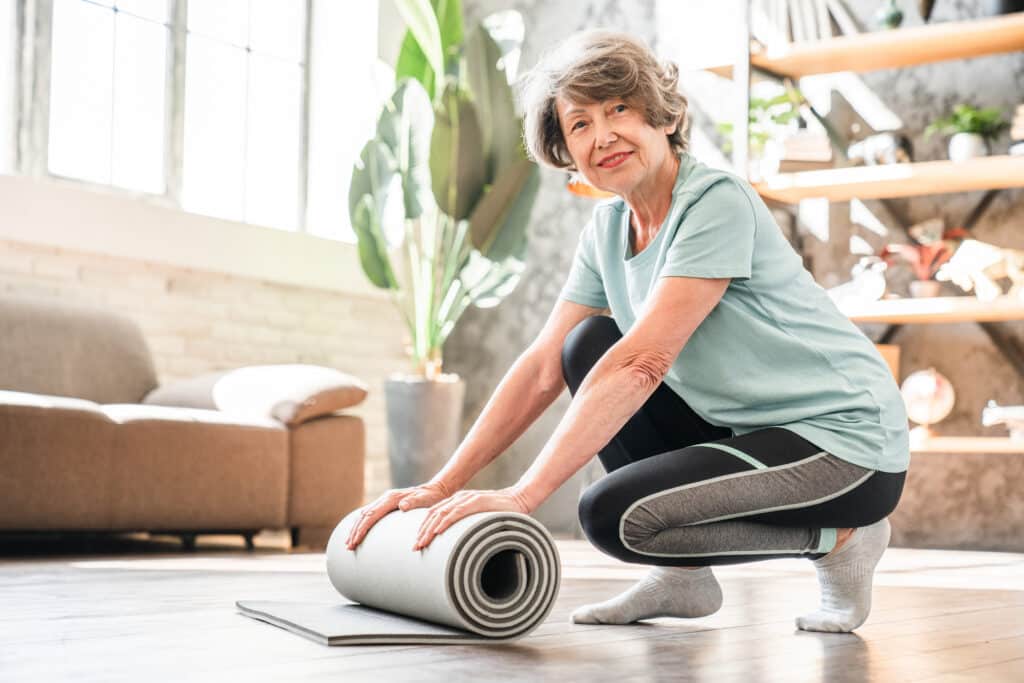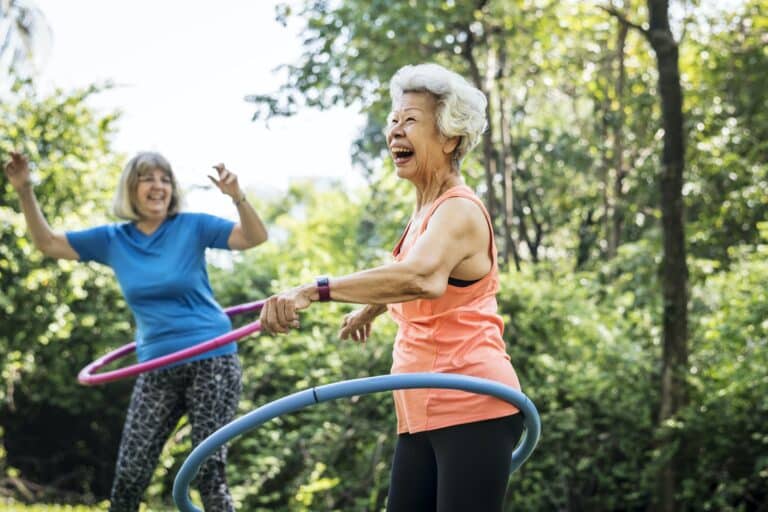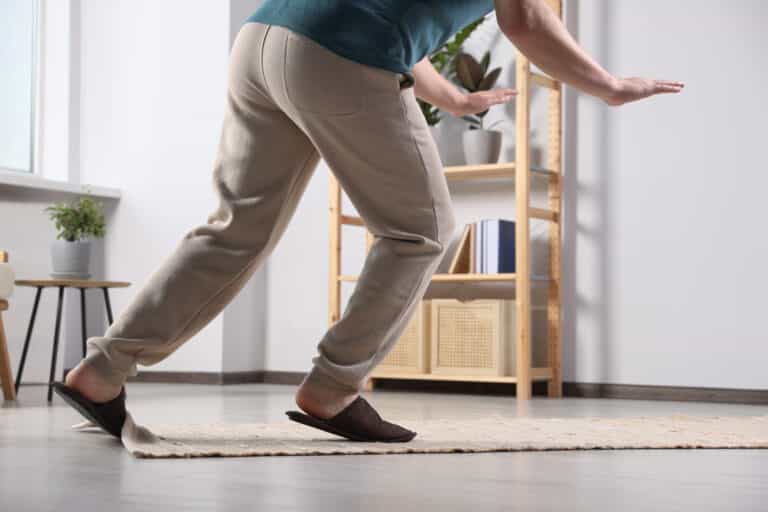The dead bug exercise may have a funny name, but it is a simple and effective exercise that can help you strengthen your core muscles and regain stability.
Many older adults experience low back pain, sciatica, and other conditions related to weak abdominal muscles that can challenge their ability to do simple daily activities.
If that sounds like you, then the dead bug exercise may be just what you need to start feeling more balanced and confident in your movement.
Before you start with your dead bugs, I’d like to walk you through the benefits of this exercise and share some tips on performing this movement correctly so you can get the most out of your hard work.
Let’s examine how the dead bug exercise can improve core strength and wellness routine.
What Are the Benefits of the Dead Bug Exercise?
The dead bug exercise is named after how a dead bug looks on its back with its arms and legs in the air. It may sound silly, but it’s a very effective and simple way to strengthen your core.
But why is a strong core important anyway?
Benefits of Having a Strong “Core”
Your core muscles are crucial to stabilizing your spine, helping you move around comfortably and perform daily activities with fewer challenges.1
Your core consists of a group of muscles, including your obliques, rectus abdominis, transverse abdominis, and pelvic floor. These muscles are essential for everyday activities such as getting out of bed or walking around.2
Working on core strength can be one of the most essential parts of treating problems in other body areas, like knee pain. That’s because the alignment of your spine can affect just about every other joint in your body.
That’s right: improving strength and stability in one place can help with another.
Here are a few benefits of making this exercise a part of your routine:
- It can strengthen your core to help prevent injuries and protect your spine from too much stress.
- It can improve your flexibility and mobility, allowing you to move more freely and experience less muscle stiffness and pain.
- It can reduce low back pain by improving the alignment of your spine and reducing pressure on your discs, which can also improve your posture.
- It can improve stability and balance, which makes it safer to move around and participate in your favorite activities without fear of injury.3
By incorporating the dead bug exercise into your regular exercise regimen, you can feel more confident living an active and well-balanced lifestyle. So, how is this exercise done anyway?
Why the Dead Bug Exercise is Important
Focusing on core strength and stability as you age is more important than ever, so adding exercises like the dead bug can significantly impact your long-term health and wellness.4
The dead bug exercise is simple, safe, and easy to scale for different fitness levels. It also engages all parts of your core in ways other exercises may not.
By regularly performing the dead bug exercise, you’ll be well on your way to reduced back pain, improved posture, and more confidence moving through your daily life.
However, there are some important things to keep in mind when performing this exercise to ensure that it is done efficiently and safely.
How to Perform the Dead Bug Exercise
The dead bug exercise is a favorite among those looking to add simple core strengthening exercises to their routine.
It can be adjusted according to your fitness level. Not only does this movement challenge your core, but it also helps you maintain cross-body coordination so you can move around more freely with confidence.
Let’s start with the basics, then discuss different versions you can try.
The Basic Dead Bug Exercise
- Lie on your back and bend your knees and hips at 90 degrees so your thighs are perpendicular to the floor and your shins parallel to the floor.
- Put your arms straight up in the air, aligned with your shoulders and perpendicular to the floor.
- As you engage your core muscles, draw your belly button toward your spine and flatten your lower back against the floor. Keep your spine neutral and avoid arching or rounding it.
- Slowly lower your right arm and left leg toward the floor. Lower both limbs as far as possible while maintaining a neutral spine and engaging your core.
- Bring your arm and leg back to the starting position. Repeat the movement with your other two limbs to complete one repetition.
- Aim for 10 to 15 repetitions, but stop when you become too tired or cannot maintain good form.
This simple version is a great starting point for many of my older adult patients, and it’s usually just the right amount of challenge.
If this is too difficult (or not enough of a challenge), there are different ways to perform the exercise that may be a better fit for you. Here are some of my go-to variations.
Dead Bug Variations
One of the reasons the dead bug exercise is so popular is because everyone can benefit from it, no matter their fitness level. Here are a few ways to modify the exercise according to your fitness level:
Make the Dead Bug Exercise Easier
Try Lowering One Limb at a Time
Is the full version a bit more challenging than feels safe for you? The first modification is to try to lower one limb at a time instead of two at once.
Cue the spine for proper alignment
You can improve coordination in the lower spine by placing a folded towel under your lower back and gently pressing against the towel. This ensures that your lower back does not arch, which is more challenging for most people.
Reduced Range of Motion
To make the exercise easier, you can focus on only lowering your legs, one at a time. Simply place your hands underneath your hips and lower one bent leg to the ground.
Make the Dead Bug Exercise More Challenging
If you’ve been doing the dead bugs for a while, you may be looking for a new challenge. Here are some ways to make the dead bug exercise more challenging.
Use a Stability Ball
Lightly hold and squeeze a stability ball between your hands and knees. As you lower your arm and leg away from the ball, gently squeeze it with your other arm and leg, then switch when returning to the top position.
Use a Resistance Band
Wrap a resistance band around your feet and hold onto the ends with both hands. Lower your right arm and left leg, pulling the band with your arm and pushing it away from you with your leg. Slowly raise them back to the starting position as you release the tension in the band.
Hold a Dumbbell for an Added Strength Challenge
Hold a dumbbell with both hands above your chest. Lower both arms and one leg and keep the weight stable. Slowly raise the weight as you return to the starting position, then repeat with your opposite leg.
I always recommend starting with the basic movement and adjusting the difficulty. As you get stronger, you can try different exercise variations to see what works best for you and which ones you enjoy fitting into your exercise routine.
Tips to Get the Most out of Your Dead Bug Exercise
While the dead bug exercise can seem fairly easy to perform, there are some details you’ll want to keep in mind to get the most out of it and avoid potential injury.
Here are some tips for maximizing your results and common mistakes to avoid.
Tips for Success
- Take full breaths as you slowly exhale through your mouth while bringing your arm and leg back to the starting position, and inhale through your nose (or mouth) as you lower them toward the floor.
- Keep your shoulders and hips level and avoid twisting by moving your arm and leg at the same controlled pace during the exercise.
- Keep your core muscles engaged by visualizing which muscles you’re working with every repetition. For example, gently pull your belly button toward your spine and hold it there.
Common Mistakes
- Avoid arching or rounding your back to keep your core muscles engaged and prevent extra strain. Keep your back flat on the floor to maintain a neutral spine, and consider adding something you can press against, like a folded towel, for more feedback. If you feel your back start to arch, try modifying your range of motion until it stops rounding.
- Maintain a relaxed neck while keeping your spine aligned, and try not to lift your head from the floor. If you need to support your neck, use a rolled-up towel or small pillow for comfort.
- Don’t overdo it. Listen to the cues your body is giving and adjust the difficulty level accordingly. It’s good to push yourself, but not through pain or discomfort.
My patients see the most progress when they challenge themselves and listen carefully to what their bodies are telling them.
If you don’t feel comfortable doing this or any other exercise, consult your physical therapist for one-on-one guidance.
Summary
Despite its humorous name, the dead bug exercise is a powerful tool for older adults seeking to improve their core strength and stability. This simple and adaptable exercise can help alleviate conditions such as low back pain and sciatica and enhance balance and mobility. Remember, it’s important to perform the exercise correctly, adjust the difficulty level to your fitness needs, and listen to your body to avoid overexertion or injury.
Key Takeaways
- The dead bug exercise is a simple, adaptable way to strengthen your core muscles.
- A strong core can help prevent injuries, improve flexibility and mobility, and reduce low back pain.
- The exercise can be modified to suit different fitness levels, making it accessible for everyone.
- Proper form and mindful engagement of your core muscles are crucial for the effectiveness of the exercise.
- It’s important to listen to your body and adjust the difficulty level to avoid injury.
- Consult a physical therapist if you’re unsure about performing the exercise correctly.
References
- Granacher, U., Gollhofer, A., Hortobágyi, T. et al. The Importance of Trunk Muscle Strength for Balance, Functional Performance, and Fall Prevention in Seniors: A Systematic Review. Sports Med 43, 627–641 (2013). https://doi.org/10.1007/s40279-013-0041-1
- Oliva-Lozano JM, Muyor JM. Core Muscle Activity During Physical Fitness Exercises: A Systematic Review. Int J Environ Res Public Health. 2020 Jun 16;17(12):4306. doi: 10.3390/ijerph17124306. PMID: 32560185; PMCID: PMC7345922.
- Kang KY. Effects of core muscle stability training on the weight distribution and stability of the elderly. J Phys Ther Sci. 2015 Oct;27(10):3163-5. doi: 10.1589/jpts.27.3163. Epub 2015 Oct 30. PMID: 26644666; PMCID: PMC4668157.
- Manjusha K, Nithya Narayanan Kutty, Shilpa Chandran. The Effectiveness of Core Strength Training to Improve Functional Mobility and Balance in Geriatric Population: A Literature Review. Ortho Res Online J. 9(1). OPROJ. 000701. 2021. DOI: 10.31031/OPROJ.2021.09.000701






